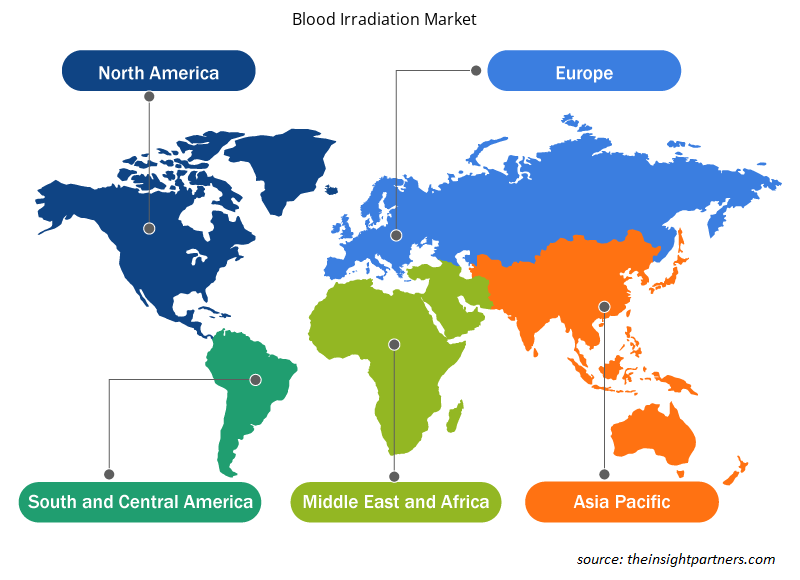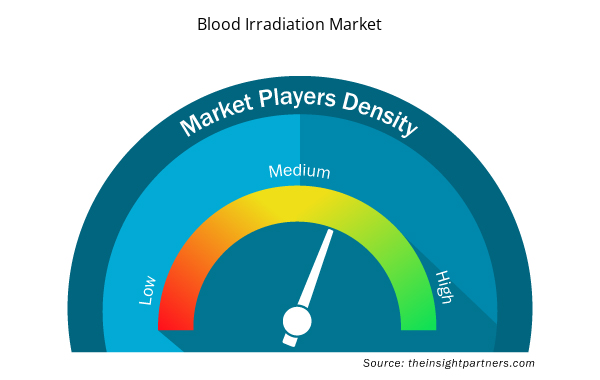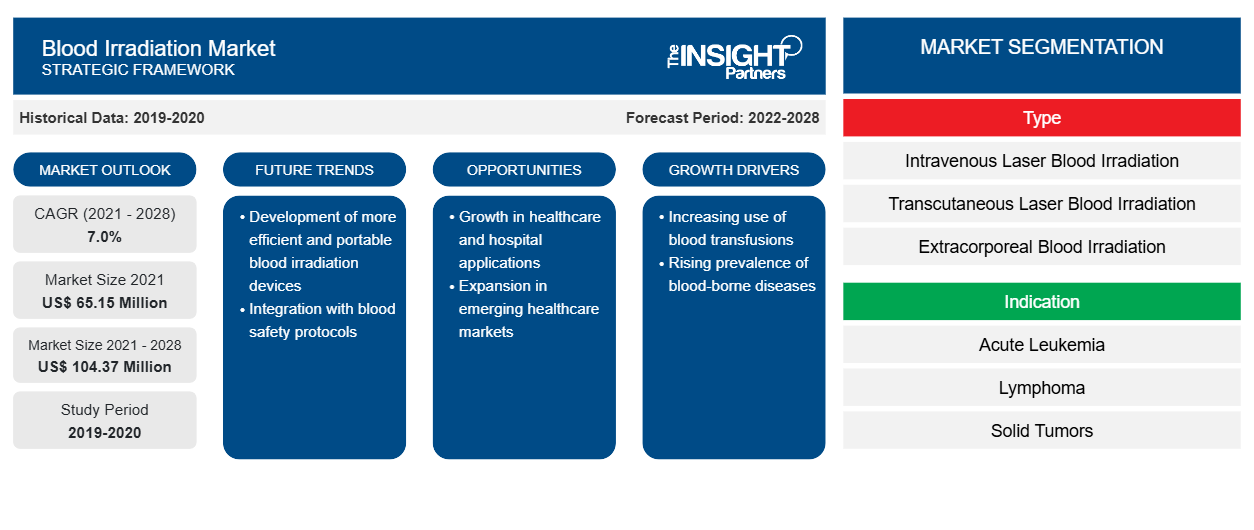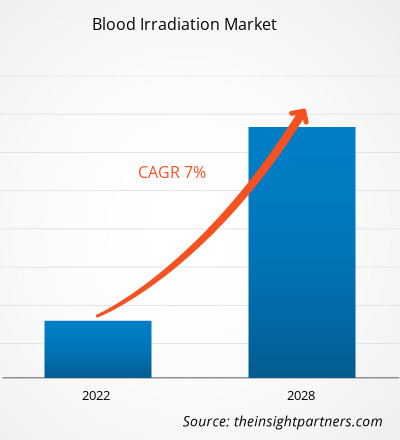Se proyecta que el mercado de irradiación sanguínea alcance los 104,37 millones de dólares en 2028, desde los 65,15 millones de dólares en 2021; se espera que crezca a una CAGR del 7,0 % entre 2022 y 2028.
La creciente prevalencia de enfermedades transmisibles y no transmisibles y el aumento de la investigación y el desarrollo impulsan el crecimiento del mercado. Sin embargo, el alto costo de la irradiación sanguínea restringe el crecimiento del mercado.
La irradiación de la sangre se logra exponiendo la sangre a al menos 25 Gy (2500 cGy ) de radiación en el centro del vaso, impidiendo la replicación y el injerto de leucocitos T inmunológicamente competentes del donante al receptor. La EICH causada por trasplantes de donantes casi siempre es mortal, por lo que los pacientes en riesgo deben recibir productos sanguíneos irradiados según lo permitan el tiempo y los recursos. Las indicaciones clínicas, que incluyen leucemia aguda , linfoma, tumores sólidos que reciben quimioterapia intensiva o radioterapia , exanguinotransfusiones, receptores de trasplantes de órganos y bebés prematuros, requieren terapia de irradiación de la sangre. Los pacientes afectados por el virus de la inmunodeficiencia humana/síndrome de inmunodeficiencia adquirida no requieren irradiación de productos sanguíneos, ya que no se ha informado que sean susceptibles a la enfermedad de injerto a huésped posterior a la transfusión.
Personalice este informe según sus necesidades
Obtendrá personalización en cualquier informe, sin cargo, incluidas partes de este informe o análisis a nivel de país, paquete de datos de Excel, así como también grandes ofertas y descuentos para empresas emergentes y universidades.
- Obtenga las principales tendencias clave del mercado de este informe.Esta muestra GRATUITA incluirá análisis de datos, desde tendencias del mercado hasta estimaciones y pronósticos.
Perspectivas del mercado
El aumento de la prevalencia de enfermedades transmisibles y no transmisibles impulsa el crecimiento del mercado
Existe un aumento en la incidencia de enfermedades transmisibles y no transmisibles, incluidos el cáncer, los trastornos cardiovasculares, la enfermedad renal crónica y los accidentes cerebrovasculares, debido a una gran población en todo el mundo susceptible a tales afecciones. Según la Organización Mundial de la Salud (OMS), los trastornos cardiovasculares son la principal causa de muerte a nivel mundial y se reportan ~17,9 millones de muertes al año. Además, la creciente prevalencia de enfermedades transmisibles, como la hepatitis, la influenza, el virus de inmunodeficiencia humana (VIH) y el síndrome de inmunodeficiencia adquirida (SIDA), están impulsando el crecimiento del mercado de irradiación de sangre . Según la OMS, 325 millones de personas se infectaron con el virus de la hepatitis B en 2020 y 900.000 personas mueren por infección por el virus de la hepatitis B cada año. Además, una gran población geriátrica en todo el mundo está contribuyendo a la prevalencia de enfermedades no transmisibles, como trastornos cardiovasculares, trastornos renales y accidentes cerebrovasculares. Según la OMS, la población de personas de 60 años o más era de 1.000 millones en 2019 y se espera que aumente a 1.400 millones en 2030 y 2.100 millones en 2050. La población de edad avanzada es susceptible a enfermedades no transmisibles debido a diversos factores, como la mala nutrición, la falta de actividad física, el uso excesivo de tabaco y el consumo de alcohol.
Además, el aumento de las transfusiones de sangre debido al aumento de los procedimientos quirúrgicos, los accidentes, los casos de traumatismos y los trastornos, junto con la creciente prevalencia de las infecciones del torrente sanguíneo, respalda el crecimiento del mercado. Las infecciones del torrente sanguíneo, las afecciones subyacentes y los procedimientos invasivos son comunes entre la población geriátrica. Las infecciones del torrente sanguíneo son la principal causa de enfermedad y muerte entre grandes poblaciones. Según la Biblioteca Nacional de Medicina, anualmente se producen alrededor de 28.000 infecciones del torrente sanguíneo en todo el mundo. Además, la creciente conciencia sobre las infecciones del torrente sanguíneo y el aumento de las respuestas inmunitarias a la sangre transfundida pueden causar complicaciones, ya que el uso cada vez mayor de sangre irradiada en el tratamiento del cáncer fortalece el sistema inmunológico y mejora la salud general de los pacientes, lo que impulsa el crecimiento del mercado de la irradiación de sangre.
Por lo tanto, el aumento de la prevalencia de trastornos transmisibles y no transmisibles, el aumento de las transfusiones de sangre, el incremento de las infecciones del torrente sanguíneo y el aumento de las respuestas inmunes están impulsando el crecimiento del mercado de irradiación de sangre.
Perspectivas basadas en tipos
El mercado de irradiación sanguínea, según el tipo, se segmenta en irradiación sanguínea con láser intravenoso, irradiación sanguínea con láser transcutáneo e irradiación sanguínea extracorpórea. En 2021, el segmento de irradiación sanguínea con láser intravenoso representó la mayor participación de mercado. Sin embargo, se espera que el segmento de irradiación sanguínea con láser extracorpóreo registre la CAGR más alta del 7,8 % durante el período de pronóstico.
Información basada en el usuario final
Según el usuario final, el mercado de irradiación de sangre se segmenta en hospitales, bancos de sangre , clínicas de diagnóstico e institutos de investigación. El segmento de hospitales tuvo la mayor participación de mercado en 2021. Sin embargo, se estima que el segmento de bancos de sangre registrará la CAGR más alta del mercado, un 7,7 %, durante el período de pronóstico.
Perspectivas regionales del mercado de irradiación sanguínea
Los analistas de Insight Partners explicaron en detalle las tendencias y los factores regionales que influyen en el mercado de irradiación sanguínea durante el período de pronóstico. Esta sección también analiza los segmentos y la geografía del mercado de irradiación sanguínea en América del Norte, Europa, Asia Pacífico, Oriente Medio y África, y América del Sur y Central.

- Obtenga datos regionales específicos para el mercado de irradiación sanguínea
Alcance del informe sobre el mercado de irradiación sanguínea
| Atributo del informe | Detalles |
|---|---|
| Tamaño del mercado en 2021 | US$ 65,15 millones |
| Tamaño del mercado en 2028 | US$ 104,37 millones |
| CAGR global (2021-2028) | 7.0% |
| Datos históricos | 2019-2020 |
| Período de pronóstico | 2022-2028 |
| Segmentos cubiertos | Por tipo
|
| Regiones y países cubiertos | América del norte
|
| Líderes del mercado y perfiles de empresas clave |
|
Densidad de actores del mercado: comprensión de su impacto en la dinámica empresarial
El mercado de la irradiación sanguínea está creciendo rápidamente, impulsado por la creciente demanda de los usuarios finales debido a factores como la evolución de las preferencias de los consumidores, los avances tecnológicos y una mayor conciencia de los beneficios del producto. A medida que aumenta la demanda, las empresas amplían sus ofertas, innovan para satisfacer las necesidades de los consumidores y aprovechan las tendencias emergentes, lo que impulsa aún más el crecimiento del mercado.
La densidad de actores del mercado se refiere a la distribución de las empresas o firmas que operan dentro de un mercado o industria en particular. Indica cuántos competidores (actores del mercado) están presentes en un espacio de mercado determinado en relación con su tamaño o valor total de mercado.
Las principales empresas que operan en el mercado de irradiación sanguínea son:
- Typenex Medical, LLC
- Sistemas médicos Hitachi
- Tecnologías de fuentes de radiación
- Gilardoni SpA
- Servicio médico Gamma GmbH
Descargo de responsabilidad : Las empresas enumeradas anteriormente no están clasificadas en ningún orden particular.

- Obtenga una descripción general de los principales actores clave del mercado de irradiación sanguínea
Perspectivas basadas en indicaciones
Según las indicaciones, el mercado de irradiación sanguínea se segmenta en leucemia aguda, tumores sólidos, tumores pélvicos, linfoma y otros. El segmento de leucemia aguda tuvo la mayor participación de mercado en 2021. Sin embargo, se estima que el segmento de linfoma registrará la CAGR más alta del mercado, del 8,8 %, durante el período de pronóstico.
Las empresas que operan en el mercado de la irradiación sanguínea adoptan la estrategia de innovación de productos para satisfacer las cambiantes demandas de los clientes en todo el mundo, lo que también les permite mantener su marca en el mercado global. Por ejemplo, en junio de 2021, Rad Source Technologies, un proveedor comercial de productos de radiación de rayos X en los EE. UU., diseñó un producto para reemplazar los irradiadores gamma autoprotegidos y presentó su irradiador de sangre RS 3400 recientemente rediseñado en MEDLAB Middle East 2021.
Mercado de irradiación sanguínea por geografía
Geográficamente, el mercado de irradiación sanguínea está segmentado en América del Norte (EE. UU., Canadá y México), Europa (Francia, Alemania, Reino Unido, España, Italia y el resto de Europa), Asia Pacífico (China, India, Japón, Australia, Corea del Sur y el resto de Asia Pacífico), Oriente Medio y África (Arabia Saudita, Emiratos Árabes Unidos, Sudáfrica y el resto de Oriente Medio y África) y América del Sur y Central (Brasil, Argentina y el resto de América del Sur y Central). Typenex Medical, LLC; Hitachi Medical Systems; Rad Source Technologies; Gilardoni SpA; Gamma-Service Medical GmbH; Actemium; y Best Theratronics Ltd. se encuentran entre los participantes del mercado incluidos en el estudio de investigación.
- Análisis histórico (2 años), año base, pronóstico (7 años) con CAGR
- Análisis PEST y FODA
- Tamaño del mercado Valor/volumen: global, regional, nacional
- Industria y panorama competitivo
- Conjunto de datos de Excel



Report Coverage
Revenue forecast, Company Analysis, Industry landscape, Growth factors, and Trends

Segment Covered
This text is related
to segments covered.

Regional Scope
North America, Europe, Asia Pacific, Middle East & Africa, South & Central America

Country Scope
This text is related
to country scope.
Preguntas frecuentes
Global blood irradiation market is segmented by region into North America, Europe, Asia Pacific, the Middle East & Africa, and South & Central America. In North America, the U.S. held the largest market share for blood irradiation market. The US is estimated to hold the largest share in the blood irradiation market during the forecast period. Increase in R&D activities along with surge in autoimmune disorders and organ transplants are the contributing factors for the regional growth. Additionally, increase in communicable and non-communicable diseases is the key factor responsible for the Asia-Pacific regional growth for blood irradiation accounting fastest growth of the region during the coming years.
Typenex Medical, LLC; Hitachi Medical Systems; Rad Source Technologies; Gilardoni S.p.A.; Gamma-Service Medical GmbH; Actemium; Best Theratronics Ltd. are among the leading companies operating in the global blood irradiation market
The acute leukemia segment dominated the global blood irradiation market and accounted for the largest revenue of 26.93 Mn in 2021.
Blood irradiation is the process in which blood is exposed to low level of radiation which deactivates the T lymphocytes and inhibits the immune response for the prevention of rare graft-versus-host disease (GVHD). This therapy is also used for the treatment of various disorders such as autoimmune disorders, cancer, neuropathies and many more.
Increase in communicable and non-communicable diseases, rise in healthcare expenditure, and government initiatives are the most significant factors responsible for the overall market growth.
Based on type, intravenous laser blood irradiation took the forefront leaders in the worldwide market by accounting largest share in 2021 and is expected to continue to do so till the forecast period.
Trends and growth analysis reports related to Life Sciences : READ MORE..
The List of Companies - Blood Irradiation Market
- Typenex Medical, LLC
- Hitachi Medical Systems
- Rad Source Technologies
- Gilardoni S.p.A.
- Gamma-Service Medical GmbH
- Actemium
- Best Theratronics Ltd.
The Insight Partners performs research in 4 major stages: Data Collection & Secondary Research, Primary Research, Data Analysis and Data Triangulation & Final Review.
- Data Collection and Secondary Research:
As a market research and consulting firm operating from a decade, we have published and advised several client across the globe. First step for any study will start with an assessment of currently available data and insights from existing reports. Further, historical and current market information is collected from Investor Presentations, Annual Reports, SEC Filings, etc., and other information related to company’s performance and market positioning are gathered from Paid Databases (Factiva, Hoovers, and Reuters) and various other publications available in public domain.
Several associations trade associates, technical forums, institutes, societies and organization are accessed to gain technical as well as market related insights through their publications such as research papers, blogs and press releases related to the studies are referred to get cues about the market. Further, white papers, journals, magazines, and other news articles published in last 3 years are scrutinized and analyzed to understand the current market trends.
- Primary Research:
The primarily interview analysis comprise of data obtained from industry participants interview and answers to survey questions gathered by in-house primary team.
For primary research, interviews are conducted with industry experts/CEOs/Marketing Managers/VPs/Subject Matter Experts from both demand and supply side to get a 360-degree view of the market. The primary team conducts several interviews based on the complexity of the markets to understand the various market trends and dynamics which makes research more credible and precise.
A typical research interview fulfils the following functions:
- Provides first-hand information on the market size, market trends, growth trends, competitive landscape, and outlook
- Validates and strengthens in-house secondary research findings
- Develops the analysis team’s expertise and market understanding
Primary research involves email interactions and telephone interviews for each market, category, segment, and sub-segment across geographies. The participants who typically take part in such a process include, but are not limited to:
- Industry participants: VPs, business development managers, market intelligence managers and national sales managers
- Outside experts: Valuation experts, research analysts and key opinion leaders specializing in the electronics and semiconductor industry.
Below is the breakup of our primary respondents by company, designation, and region:

Once we receive the confirmation from primary research sources or primary respondents, we finalize the base year market estimation and forecast the data as per the macroeconomic and microeconomic factors assessed during data collection.
- Data Analysis:
Once data is validated through both secondary as well as primary respondents, we finalize the market estimations by hypothesis formulation and factor analysis at regional and country level.
- Macro-Economic Factor Analysis:
We analyse macroeconomic indicators such the gross domestic product (GDP), increase in the demand for goods and services across industries, technological advancement, regional economic growth, governmental policies, the influence of COVID-19, PEST analysis, and other aspects. This analysis aids in setting benchmarks for various nations/regions and approximating market splits. Additionally, the general trend of the aforementioned components aid in determining the market's development possibilities.
- Country Level Data:
Various factors that are especially aligned to the country are taken into account to determine the market size for a certain area and country, including the presence of vendors, such as headquarters and offices, the country's GDP, demand patterns, and industry growth. To comprehend the market dynamics for the nation, a number of growth variables, inhibitors, application areas, and current market trends are researched. The aforementioned elements aid in determining the country's overall market's growth potential.
- Company Profile:
The “Table of Contents” is formulated by listing and analyzing more than 25 - 30 companies operating in the market ecosystem across geographies. However, we profile only 10 companies as a standard practice in our syndicate reports. These 10 companies comprise leading, emerging, and regional players. Nonetheless, our analysis is not restricted to the 10 listed companies, we also analyze other companies present in the market to develop a holistic view and understand the prevailing trends. The “Company Profiles” section in the report covers key facts, business description, products & services, financial information, SWOT analysis, and key developments. The financial information presented is extracted from the annual reports and official documents of the publicly listed companies. Upon collecting the information for the sections of respective companies, we verify them via various primary sources and then compile the data in respective company profiles. The company level information helps us in deriving the base number as well as in forecasting the market size.
- Developing Base Number:
Aggregation of sales statistics (2020-2022) and macro-economic factor, and other secondary and primary research insights are utilized to arrive at base number and related market shares for 2022. The data gaps are identified in this step and relevant market data is analyzed, collected from paid primary interviews or databases. On finalizing the base year market size, forecasts are developed on the basis of macro-economic, industry and market growth factors and company level analysis.
- Data Triangulation and Final Review:
The market findings and base year market size calculations are validated from supply as well as demand side. Demand side validations are based on macro-economic factor analysis and benchmarks for respective regions and countries. In case of supply side validations, revenues of major companies are estimated (in case not available) based on industry benchmark, approximate number of employees, product portfolio, and primary interviews revenues are gathered. Further revenue from target product/service segment is assessed to avoid overshooting of market statistics. In case of heavy deviations between supply and demand side values, all thes steps are repeated to achieve synchronization.
We follow an iterative model, wherein we share our research findings with Subject Matter Experts (SME’s) and Key Opinion Leaders (KOLs) until consensus view of the market is not formulated – this model negates any drastic deviation in the opinions of experts. Only validated and universally acceptable research findings are quoted in our reports.
We have important check points that we use to validate our research findings – which we call – data triangulation, where we validate the information, we generate from secondary sources with primary interviews and then we re-validate with our internal data bases and Subject matter experts. This comprehensive model enables us to deliver high quality, reliable data in shortest possible time.


 Obtenga una muestra gratuita de este informe
Obtenga una muestra gratuita de este informe